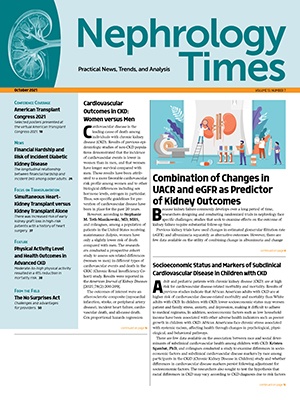
Routine medical care for adults includes clinical assessment of kidney function. Estimates of glomerular filtration rate (GFR) incorporate clinical and demographic factors, including age, sex, and race, that explain some of the variation of markers unrelated to GFR; estimated GFR (eGFR) is more accurate and useful than serum concentrations of endogenous filtration markers alone in each demographic group.
Most laboratories report eGFR when serum creatinine is measured (eGFRcr). Confirmatory tests for eGFRcr include eGFR based on cystatin C (eGFRcys) or the combination of creatinine and cystatin C (eGFRcr-cys). The inclusion of creatinine in eGFRcr-cys requires specification of the patient’s race. There is mounting scrutiny of the use of race in estimation of GFR, including attention by the US Congress to algorithms that include race.
According to Lesley A. Inker, MD, MS, and colleagues, a panel of endogenous filtration markers could improve the accuracy of GFR estimation by reducing the impact of the non-GFR determinants of each marker and by obviating clinical and demographic factors, particularly race.
ß2-microglobulin (B2M) and B-trace protein (BTP) are low-molecular-weight proteins that are filtered by the glomeruli and degraded by tubules. Those markers are useful in estimating GFR and are less influenced by age, sex, and race than creatinine. Dr. Inker et al. conducted an analysis to determine whether the inclusion of B2M and BTP in a panel eGFR would enable performance comparable to or better than currently recommended equations without the need for creatinine or race. Results of the analysis were reported in the American Journal of Kidney Diseases [2021;77(5):673-683].
The analysis included seven studies with a total of 5017 participants in the development population. The data set was randomly divided into separate datasets for initial development (n=3363) and internal validation (n=1654). Seven additional studies with a total of 2245 participants were included in the external validation population.
The researchers developed new equations using both B2M and BTP rather than either alone, with creatinine (4-marker panels) and without creatinine (3-marker panels). Each was tested with and without a race coefficient. Reference equations used were the 2009 Chronic Kidney Disease Epidemiology Collaboration (CKD-EPI), the 2012 CKD-EPI cystatin C equation, and the 2012 CKD-EPI creatinine-cystatin C equation.
In the development population, mean measured GFR (mGFR) was 58.1 mL/min/1.73 m2, mean age was 55.7 years, 43.8% were female, and 38.6% were Black. In the validation population, mean mGFR was 83.2 mL/min/1.73 m2, mean age was 52.8 years, 29% were female, and 24% were Black. Five of the seven development cohorts included Black participants (>5% in three of the seven cohorts and 39% overall) and in all validation cohorts (>5% in five of the seven cohorts and 24% overall). In the development cohort, 1296 participants had diabetes, and mean body mass index (BMI) was 29.0 kg/m2. In the external validation cohort, 34.7% had diabetes and mean BMI was 27.5 kg/m2.
All filtration markers were correlated negatively with mGFR and positively with each other in the development population. Following adjustment for mGFR, the correlations among filtration markers ranged from 0.508 (95% confidence interval [CI], 0.487-0.528) for creatinine and BTP to 0.774 (95% CI, 0.762-0.785) for cystatin C and B2M.
Regardless of inclusion or exclusion of age and sex or race, 4-marker panels were more accurate than corresponding 3-marker panels. The addition of age and sex improved the performance of the 3-marker and 4-marker panels compared with panels without age and sex. The addition of race did not improve performance further. In subgroups of participants from Black versus other communities, results were generally similar.
In the external validation cohort, the 4-marker panels were more accurate than the 3-marker panels (P<.001). The 3-marker panel without race was more accurate than eGFRcys, and the 4-marker panel without race was as accurate as eGFRcr-cys. Across subgroups, results were generally consistent.
Limitations to the findings cited by the authors included lack of representation of participants with severe comorbid illness and from geographic areas outside North America and Europe. In addition, the mean GFR in the development population was higher than in the CKD populations used to develop the 2015 equations and lower than in the development populations for the 2009 creatinine and 2021 cystatin C equations and the external validation population in the current study.
In conclusion, the researchers said, “We present 3-marker and 4-marker panel eGFRs that use B2M and BTP but do not include race as confirmatory or alternative rests for eGFRcr. The 4-marker panel eGFR is less dependent on creatinine and is as accurate as the 2012 creatinine-cystatin C equation. An eGFR that does not require race and is less dependent on creatinine could provide more robust GFR estimates across a greater variety of populations. Further studies are required to understand how best to use these equations in clinical practice, especially in diverse clinical settings and geographic locations.”
Takeaway Points
- The inclusion of creatinine in assessment of glomerular filtration rate (GFR) requires specification of a patient’s race. Alternate filtration markers that may be less influenced by race are ß2-microglobulin (B2M) and B-trace protein (BTP).
- Researchers utilized a pooled dataset of seven studies to develop new estimating equations based on combinations of the markers with and without age, sex, or race.
- Using a separate dataset of seven studies, an equation that used all four markers, including age and sex but not race, was as accurate as estimated GFR based on the combination of creatinine and cystatin C.







 © 2025 Mashup Media, LLC, a Formedics Property. All Rights Reserved.
© 2025 Mashup Media, LLC, a Formedics Property. All Rights Reserved.